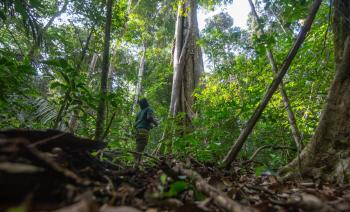Nota conceptual que recoge el contexto, antecedentes y diseño de intervención del Programa Grandes Bosques de Mesoamérica (PGBM), una iniciativa mesoamericana escalada por la Unión Europea y el Equipo Europa, con el co...
Description
The EU-Central America Cooperation Mechanism (EUreCA) aims to support the realization of the potential of Central American integration as an engine of sustainable development in the subregion, promoting stability, peace and the reduction of inequalities. In the spirit of international partnerships, the mechanism affirms regional and bi-regional dialogue, focusing on common policy priorities, including green and blue recovery, digitalisation, gender equality and the fight against inequalities. The Facility will also focus on strategic communication activities, including large-scale public campaigns, designed to raise awareness and support the EU's political priorities in Central America, as well as specific political communication campaigns and products. Additionally, it will facilitate the design and implementation of EU actions in the subregion, including through articulated activities to design, strengthen and connect networks. All of the above in accordance with the Central American Sub-window 2021-2027 and the Multiannual Indicative Program for the Americas and the Caribbean for the period 2021-2027.
Central America is the only subregion that has a comprehensive Association Agreement, although not fully ratified, it will continue to be the fundamental political instrument for political, trade and cooperation relations at the bi-regional level. While political differences among member countries have slowed the process of Central American integration, it has never stopped. At the technical level, remarkable results have been obtained in areas such as economic integration, energy and climate change. The integration process remains a force for stability and positive transformation beyond national politics and, as such, must be supported. The intervention seeks to help nurture processes, regional and national instances, maximise their impact on Central American countries and promote the EU's vision of regional integration as a driver of prosperity and peace, while pursuing greater alignment with the sub-region in the strategic priorities of the EU Global Agenda.
Secretariat of the Great Forests of Mesoamerica Program
Although Mesoamerica's biodiversity hotspots cover less than 0.5% of the planet's land, they contain between 7 and 10% of all known life forms, including 17% of all terrestrial species (CEPF 2004). The region is one of the most biologically diverse on the planet. The Great Forests of Mesoamerica (covering southeastern Mexico, Belize, Guatemala, Honduras, Nicaragua, Costa Rica, and Panama) contain about half of the region's forest carbon stocks, helping slow climate change and they are also essential for wildlife and people. They provide water, clean air, wood and non-wood products for food security, and other vital natural resources for 5 million people. Indigenous and local communities occupy 48% of the forests in Central America, the presence of these communities has allowed the conservation of these ecosystems.
However, Mesoamerica is highly exposed, vulnerable and heavily impacted by climate change, a situation amplified by inequality, change in land use (particularly deforestation and forest degradation with the consequent loss of biodiversity), and high dependence on national and local economies of natural resources for the production of basic products (IPCC 2022). Added to this are challenges in the capacities to enforce environmental legislation in order to stop illegal deforestation and land invasions, the presence of organized crime (connected to drug trafficking), the migration crisis, and the increase in violence against people. environmental and human rights defenders.
As a result, the last remaining forests are being destroyed at an alarming rate; three of the great forests of Mesoamerica have been reduced by more than 23% since the year 2000, mainly as a result of agricultural activities and especially illegal cattle ranching for export. Additionally, Mesoamerican countries have the highest per capita rate of violence against environmental defenders in the world (Global Witness 2021). Hence, different actors are joining efforts through multi-actor and multi-sectoral actions to ensure the conservation of the Great Forests of Mesoamerica.
Overall Objective (Impact)
Support the bi-regional partnership between the EU and Central America in line with the principles and objectives of the EU-CA Association Agreement, focusing on common political priorities, including green and blue recovery, digitalization, gender equality and the fight against inequalities. Protection and sustainable use of the Five Great Forests of Mesoamerica (and other relevant forest areas in the region).
Secretariat of the Five Great Forests of Mesoamerica Program
• There is a growing recognition among countries and stakeholders that joining efforts around the sustainable management and conservation of the Five Great Forests of Mesoamerica presents a unique opportunity for a paradigm shift; in which climate, biodiversity, sustainable forestry and human development are jointly addressed to ensure a better future. There are several very relevant initiatives from regional organizations, countries, indigenous peoples and local communities, NGOs, European Union cooperation, other donors and the private sector that contribute to this ambition. However, better coordination is needed to strengthen synergies and increase their effectiveness.
• In this context, the European Union will finance an Action (ACT-61449) that aims to improve the protection and sustainable use of the Five Great Forests of Mesoamerica (and other relevant forest areas in the region). It will follow a multi-pronged approach by simultaneously strengthening forest governance, improving sustainable forest management, protecting biodiversity, combating climate change, promoting sustainable livelihoods and trade, reducing inequalities and the benefit of the local population, especially those living in the most vulnerable situations. The action will focus on four components: 1) Data for Transparency and Decision Making, 2) Forest Governance and Biodiversity, 3) Sustainable Production and Trade, and 4) Environmental Rights and Defenders.
• It will be implemented through Member State agencies such as AECID, GIZ, EF and ASDI; as well as an international organization that will manage a mechanism for the protection of environmental defenders. Additionally, in order to ensure coordination and harmonization, there will be a Secretariat for the Program. Although the financial decision is for a term of 60 months, it is estimated that the implementation period of activities will be 48 months and the total budget for the action will be for an amount of 25.5 million euros.
The specific objectives (Effects) of this contract are the following:
• Objective 1: Support the effective and efficient implementation of EU priorities and programs in the sub-region, ensuring their alignment with regional strategies.
• Objective 2: Support the Central American regional integration process as an engine of stability, peace, sustainable and inclusive development, including through public diplomacy activities designed to build, strengthen and connect regional networks.
• Objective 3: Increase public awareness, understanding and support of the EU's values, priorities and partnership with the region, including the Team Europe approach and the applicable Global Gateway strategy, through communication activities strategy aimed at specific audiences.
• Objective 4: Implement the EU-Panama Cooperation Facility in accordance with its three lines of action (1. Prepare/strengthen/complement cooperation initiatives at the country level; 2. Support political dialogues and dialogues/consultations on EU-Panama policies; 3. Strengthen strategic communication and public diplomacy in Panama).
• Objective 5: Implement the Secretariat of the Five Great Forests of Mesoamerica Program to ensure coherence and adequate coordination between the components and with other interventions (financed by the EU and other donors).
Countries of the Central American Regional Integration System (Panama, Costa Rica, Nicaragua, Honduras, Dominican Republic, El Salvador, Belize, Guatemala) Inludeded Mexico and Colombia for the Secretariat of the Five Great Forests of Mesoamerica Program
Target groups
The main target group is the countries belonging to the Central American Integration System (SICA). Likewise, the different regional integration institutions of strategic relevance for the focal areas of the Central American sub-window will be addressed, for example the General Secretariat of SICA, the Secretariat for Economic Integration in Central America (SIECA), the Central American Commission for Environment and Development (CCAD), the Secretariat for Central American Social Integration (SISCA), Organization of the Fisheries and Aquaculture Sector of the Central American Isthmus (OSPESCA), Ad-hoc Group of the Regional Digital Strategy (ERDI), the Council of Ministers of Women of Central America and the Dominican Republic (COMMCA).
![]()












